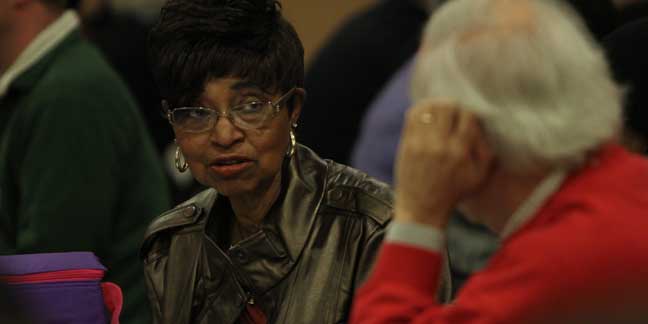 CHARLOTTE — “Get out of your comfort zone.” That was one of the conclusions drawn during a frank conversation on racism organized by two Charlotte parishes directly affected by recent racial unrest.
CHARLOTTE — “Get out of your comfort zone.” That was one of the conclusions drawn during a frank conversation on racism organized by two Charlotte parishes directly affected by recent racial unrest.
Protests and violence erupted in Charlotte last September following the fatal police shooting of Keith Lamont Scott and the subsequent shooting death of protestor Justin Carr. The week-long protests swirled around St. Peter Church, a majority white parish in uptown Charlotte. And the majority-black congregation at Our Lady of Consolation Church mourned the death of 26-year-old Carr, whose family has been members for three generations.
In response, the Black Culture Commission of Our Lady of Consolation Church and the Social Justice Ministry of St. Peter Church arranged the Dec. 10 event, “Charlotte Catholics: Our Stories in Black and White,” to talk about the personal and social wounds that the unrest exposed. More than 200 people from 11 parishes participated in the four-hour discussion.
“Our views from either side are different, we know that,” acknowledged Toni Tupponce, one of the organizers from Our Lady of Consolation Church. But, she added, “when we do nothing and we say nothing, we look around and say it’s not our problem – a couple of months ago, that scourge hit our very doors here when Justin Carr was killed in uptown Charlotte, and we’re still feeling that pain. We must do something. It is, in fact, our problem. It is the Church’s problem because we are the Church.”
Rocky Whitaker, a member of Our Lady of Consolation Church, recounted a recent family gathering at a resort. His mother asked him to take out the trash one night – something most people would do without thinking, he said, but for a black man it’s not so simple.
Whitaker described his thought process at that moment: “Here I am outside, it’s dark, I got a bag, (security) don’t know me. I’d better have my license just so I can prove that I belong on this property. So I go back and get my license.” But he didn’t have a pocket for his wallet and keys, so he thought about tucking them in his sock. “Oh, no, not a good idea. I should not do that,” in case someone might think he’s reaching for a gun. He ended up changing his pants and swapping his hoodie for a jacket, then “make sure I got my ID in my hand, go grab the trash, walk out through the door, put the trash away and come back. But before I left I had to stop – I had to go through a checklist to make sure that I felt safe about taking out the dad-gone trash. I had to sort of chuckle to myself – it’s funny, but it’s not funny.”
That mental “checklist” is something he’s been conscious of doing since he was about 12 years old, “so you don’t give anybody any excuses to do anything or to say anything,” he said. “But why did I have to go through a checklist just to take out the trash? Something’s not right with that picture.”
Talking honestly about situations like this is critical, he insisted. “Why should we have this conversation? Because we should. It’s our responsibility. Why should we Catholics have this conversation? Because we’re Christians.”
Mercy Sister Rose Marie Tresp, who has worked on race relations and social justice issues for decades, talked about recognizing her own unconscious biases and the sensitive issue of “white privilege,” as well as the Church’s admittedly slow response to racial injustice.
The U.S. bishops’ statement 1979 pastoral statement “Brothers and Sisters to Us” was a case in point, she said. Not only did it come decades after Catholics had joined in the civil rights movement, she said, but “listen to that title: ‘Brothers and Sisters to Us.’ Who is the ‘us’? I’m sure they didn’t realize it, but instead of saying ‘we’re all brothers and sisters,’ they saw the Church as a white Church inviting in the African-American Catholics to the club, rather that realizing that we’re all already in the club!”
“Civil rights ended segregation, but it didn’t end, or even know how to deal with bringing an end to the fears, the prejudices, the price and the irrational barriers to a truly integrated society,” she said.
As they sat down to share a meal together in small groups, participants also shared their personal experiences with racism or implicit bias, examining their own viewpoints and listening to others’ opinions.
Some said they struggled with what actually involves racism: “We use the word, but what does it mean? Does it look different to different people?” asked one white woman. Replied a black man sitting next to her, “There’s the way you see it, there’s the way I see it, and then there’s the way it is.”
“We all want the same thing regardless of who we are or where we came from,” said one participant. “Listening is a form of love.”
As they talked, participants came to the same conclusions: Continue the conversation on race, even when it feels uncomfortable. Get young people involved in bridging the racial divide. Remove barriers to a quality education – including greater financial assistance for poor children of color to attend Catholic school, which is too often seen as a privilege that only rich white people can afford.
And one suggestion that was repeated over and over again: Attend Mass at a parish “that looks different than you do.”
“Remember, the Catholic Church is a universal Church,” said one participant. “This is especially a challenge to us that are at white Catholic churches. Try, really try to go to a church with people that don’t look like you.”
— Patricia L. Guilfoyle, Editor


